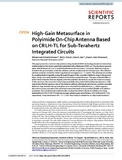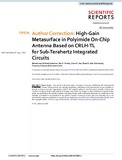Mostrar el registro sencillo del ítem
High-gain metasurface in polyimide on-chip antenna based on CRLH-TL for sub-terahertz integrated circuits
| dc.creator | Alibakhshikenari, Mohammad | es_ES |
| dc.creator | Virdee, Bal S. | es_ES |
| dc.creator | See, Chan H. | es_ES |
| dc.creator | Abd-Alhameed, Raed | es_ES |
| dc.creator | Falcone Lanas, Francisco Javier | es_ES |
| dc.creator | Limiti, Ernesto | es_ES |
| dc.date.accessioned | 2020-08-05T06:00:28Z | |
| dc.date.available | 2020-08-05T06:00:28Z | |
| dc.date.issued | 2020 | |
| dc.identifier.issn | 2045-2322 | |
| dc.identifier.uri | https://hdl.handle.net/2454/37659 | |
| dc.description | Incluye fe de erratas | es_ES |
| dc.description.abstract | This paper presents a novel on-chip antenna using standard CMOS-technology based on metasurface implemented on two-layers polyimide substrates with a thickness of 500 μm. The aluminium ground-plane with thickness of 3 μm is sandwiched between the two-layers. Concentric dielectric-rings are etched in the ground-plane under the radiation patches implemented on the top-layer. The radiation patches comprise concentric metal-rings that are arranged in a 3 × 3 matrix. The antennas are excited by coupling electromagnetic energy through the gaps of the concentric dielectric-rings in the ground-plane using a microstrip feedline created on the bottom polyimide-layer. The open-ended feedline is split in three-branches that are aligned under the radiation elements to couple the maximum energy. In this structure, the concentric metal-rings essentially act as series left-handed capacitances CL that extend the effective aperture area of the antenna without affecting its dimensions, and the concentric dielectric rings etched in the ground-plane act as shunt left-handed inductors LL, which suppress the surface-waves and reduce the substrates losses that leads to improved bandwidth and radiation properties. The overall structure behaves like a metasurface that is shown to exhibit a very large bandwidth of 0.350–0.385 THz with an average radiation gain and efficiency of 8.15dBi and 65.71%, respectively. It has dimensions of 6 × 6 × 1 mm3 that makes it suitable for on-chip implementation. | en |
| dc.description.sponsorship | This work is partially supported by RTI2018-095499-B-C31, Funded by Ministerio de Ciencia, Innovación y Universidades, Gobierno de España (MCIU/AEI/FEDER,UE), and innovation programme under grant agreement H2020-MSCA-ITN-2016 SECRET-722424 and the financial support from the UK Engineering and Physical Sciences Research Council (EPSRC) under grant EP/E022936/1. | en |
| dc.format.extent | 9 p. | |
| dc.format.mimetype | application/pdf | en |
| dc.language.iso | eng | en |
| dc.publisher | Nature Research | en |
| dc.relation.ispartof | Scientific Reports, 2020, 10:4298 | en |
| dc.rights | © The Author(s) 2020. This article is licensed under a Creative Commons Attribution 4.0 International License, which permits use, sharing, adaptation, distribution and reproduction in any medium or format, as long as you give appropriate credit to the original author(s) and the source, provide a link to the Creative Commons license, and indicate if changes were made. The images or other third party material in this article are included in the article’s Creative Commons license, unless indicated otherwise in a credit line to the material. If material is not included in the article’s Creative Commons license and your intended use is not permitted by statutory regulation or exceeds the permitted use, you will need to obtain permission directly from the copyright holder. | en |
| dc.rights.uri | http://creativecommons.org/licenses/by/4.0/ | |
| dc.subject | On-chip antennas | en |
| dc.subject | Metasurface | en |
| dc.title | High-gain metasurface in polyimide on-chip antenna based on CRLH-TL for sub-terahertz integrated circuits | en |
| dc.type | info:eu-repo/semantics/article | en |
| dc.type | Artículo / Artikulua | es |
| dc.contributor.department | Ingeniería Eléctrica, Electrónica y de Comunicación | es_ES |
| dc.contributor.department | Ingeniaritza Elektrikoa, Elektronikoa eta Telekomunikazio Ingeniaritza | eu |
| dc.rights.accessRights | info:eu-repo/semantics/openAccess | en |
| dc.rights.accessRights | Acceso abierto / Sarbide irekia | es |
| dc.identifier.doi | 10.1038/s41598-020-61099-8 | |
| dc.relation.projectID | info:eu-repo/grantAgreement/European Commission/Horizon 2020 Framework Programme/722424 | en |
| dc.relation.publisherversion | https://doi.org/10.1038/s41598-020-61099-8 | |
| dc.type.version | info:eu-repo/semantics/publishedVersion | en |
| dc.type.version | Versión publicada / Argitaratu den bertsioa | es |
Ficheros en el ítem
Este ítem aparece en la(s) siguiente(s) colección(ones)
La licencia del ítem se describe como © The Author(s) 2020. This article is licensed under a Creative Commons Attribution 4.0 International
License, which permits use, sharing, adaptation, distribution and reproduction in any medium or format, as long as you give appropriate credit to the original author(s) and the source, provide a link to the Creative Commons license, and indicate if changes were made. The images or other third party material in this article are included in the article’s Creative Commons license, unless indicated otherwise in a credit line to the material. If material is not included in the article’s Creative Commons license and your intended use is not permitted by statutory regulation or exceeds the permitted use, you will need to obtain permission directly from the copyright holder.




